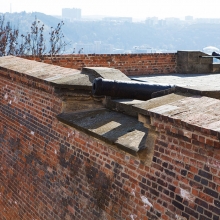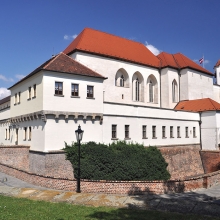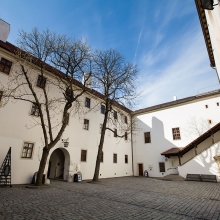Devilish Plan or How to Get Rid of Napoleon
By the way, there might have been a chance to force the French march fast from Špilberk back to Paris with catastrophic news, may a certain Kristl from Bouzov (Busau), an apprentice at Mittermaier´s guild in Brno, have succeeded in validating his idea. “Napoleon is a damned man, he brought nothing else but bad luck and war to us. I will take my rifle and make it short,“ he said to his master. The apprentice had a plan to shoot Napoleon dead at the moment he would pass through Brněnská brána (Brno Gate) towards the Špilberk Castle. Even though his words were brave, in fact he failed to complete his intentions. Who knows what happened? Maybe, he was not really serious about it, maybe his rifle failed to shoot or it was his master who persuaded him not to do so. Anyway, Napoleon survived and he was crossing Europe in good health 16 more years and in 1809 he returned back to Brno again. It was in the period of Austrian defeats near Wagram and Znojmo. Under the cease-fire, the French army occupied a part of South Moravia including Špilberk.
This time Brno and its citizens were not inflicted so much as during the first occupation, however it had fatal consequences for the Špilberk Castle. When Napoleon examined it closely again, he had its walls demolished and ordered to land up the well as he did not want to leave such a strong fortress behind. Thus, Špilberk definitely lost its original military significance[49]. Since about the middle of 19th century, Špilberk had served as barracks for soldiers for more than a hundred years. Later the Špilberk prisoners suffered there two more times – those imprisoned of military but most of all of political reasons. First, it was during the World War I and second, a much more severe situation, during the first year of Nazi occupation of Czechoslovakia. A number of detained Czech patriots lost their lives there.
Špilberk is a place of interest even today. In its museum you can find seven permanent expositions devoted to the history of Brno, arts and architecture as well as a wide selection of short-time exhibitions. During summer months the Castle courtyard and other premises are venues for various culture events, concerts, theatre performaces or historic scenes. A visit to mysterious and obscure underground labyrinth of casemates may serve as a high spot event for the braves - even today it is a rather grim experience.
Heroic Decease of General Valhubert
Another place to remind the Battle of the Three Emperors is the grave-stone commemorating General Valhubert – a French officer in the highest rank who lost his life in the battle. It is placed in “Tyršův sad” (Tyrš´ Garden) between Kounicova and Botanická Streets – not far from the Brno centre. Jean-Marie Mellon Roger-Valhubert, known as General Valhubert was in charge of defending the Santon Hill occupied by the French against Bagration´s Allied corps during the Battle of Austerlitz. He was deadly wounded somewhere there by a cannon ball or a shrapnel[10]. He passed away keeping his heroism until the very last moments – when his soldiers wanted to help him, he thundered at them: “Return to your positions, I will die here. It is useless to lose six more men because of me!“ He did not complain of his heavy wounds nor did he groan at all. He must have suffered a lot, nevertheless, he was able to dictate his last will: “Go and tell the Emperor that I would die within an hour. I wanted to achieve more ... I leave my family in his hands.“ Though objecting the soldiers transferred him to the field hospital in Šlapanice and later to Brno. In spite the utmost care the General passed away three days later.
 Hrad Spilberk.jpg)








